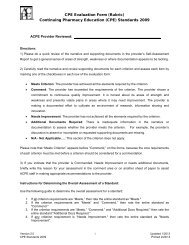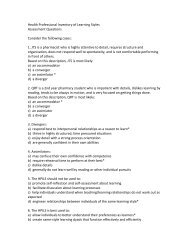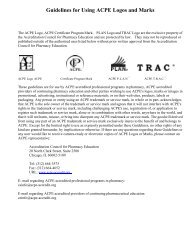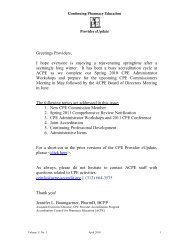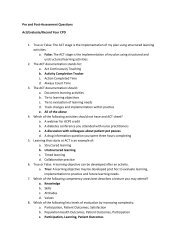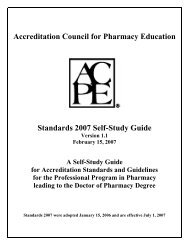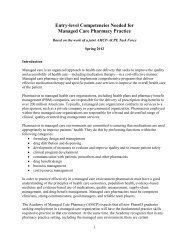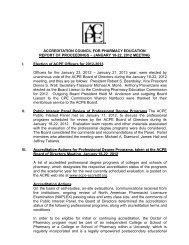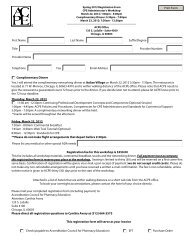Health Professionals Inventory of Learning Styles (H-PILS)
Health Professionals Inventory of Learning Styles (H-PILS)
Health Professionals Inventory of Learning Styles (H-PILS)
You also want an ePaper? Increase the reach of your titles
YUMPU automatically turns print PDFs into web optimized ePapers that Google loves.
THE HEALTH PROFESSIONALS’ INVENTORY OF LEARNING STYLES (H-<strong>PILS</strong>)<br />
Think about a few recent situations where you had to learn something new to solve a problem. This could be any<br />
kind <strong>of</strong> situation: While you were taking a course at school, learning to use new s<strong>of</strong>tware, or figuring out how to<br />
assemble a barbecue.<br />
Now, circle the letter in the column that best characterizes what works best for you in situations like<br />
the ones you’ve thought about.<br />
When I’m trying to learn something new Usually Sometimes Rarely Hardly<br />
1. I like to watch others before trying it for myself. B D C A<br />
2. I like to consult a manual, textbook or instruction guide first. B C D A<br />
3. I like to work by myself rather than with other people. A C B D<br />
4. I like to take notes or write things down as I’m going along. B C D A<br />
5. I’m critical <strong>of</strong> myself if things don’t work out as I hoped. B C D A<br />
6. I usually compare myself to other people just so I know<br />
I’m keeping up.<br />
B D C A<br />
7. I like to examine things closely instead <strong>of</strong> jumping right in. B D C A<br />
8. I rise to the occasion if I’m under pressure. C A B D<br />
9. I like to have plenty <strong>of</strong> time to think about something new<br />
before trying it.<br />
D B C A<br />
10. I pay a lot <strong>of</strong> attention to the details. B C A D<br />
11. I concentrate on improving on the things I did wrong<br />
in the past.<br />
C A D B<br />
12. I focus on reinforcing the things I got right in the past. B D A C<br />
13. I like to please the person teaching me. D B A C<br />
14. I trust my hunches. D C A B<br />
15. I’m usually the first one in a group to finish whatever<br />
we’re doing.<br />
A C D B<br />
16. I like to take charge <strong>of</strong> a situation. C A B D<br />
17. I’m well-organized. B A C D<br />
Now, add up the number <strong>of</strong> times you circled each letter.<br />
A = ________ B = ________ C = ________ D = ________<br />
Your DOMINANT learning style is the letter you circled most frequently.<br />
Your SECONDARY learning style is the next most-frequently circled letter.
A= Accommodator<br />
You enjoy dealing directly with people and have little time or patience for indirect or s<strong>of</strong>t-sell jobs. You enjoy<br />
looking for, and exploiting, opportunities as they arrive, and you have an entrepreneurial spirit. You learn best in<br />
a hands-on, unencumbered manner, not in a traditional lecture-style format. Though you don’t take any particular<br />
pleasure in leading others, you do so because you sense you are best-suited for the job. You are confident, have<br />
strong opinions and value efficiency. You are concerned about time and like to see a job get done. Sometimes,<br />
however, your concern with efficiency means that the quality <strong>of</strong> your work may suffer and you may not be paying as<br />
much attention to others’ feelings and desires as you ought to.<br />
B= Assimilator<br />
You generally prefer working by yourself, at your own pace, in your own time, or with a very small group <strong>of</strong> likeminded<br />
people. You tend to avoid situations where you are the center <strong>of</strong> attention, or you are constantly being<br />
watched—you prefer to be the one observing (and learning) from others. You have an ability to learn from your<br />
own, and others’, mistakes. You place a high priority on getting things done properly, according to the rules but, at<br />
times, you can be your own worst critic. You value organization and attentiveness to detail.<br />
C= Converger<br />
You are focused, practical and to the point. You usually find yourself in a leadership role and enjoy this challenge.<br />
You have little time or patience for those who dither or are indecisive or who spend too much time on impractical,<br />
theoretical matters. You are good at coming to quick, decisive conclusions, but you recognize that at times your<br />
speed may result in less than perfect results. You would rather get a good job done on time than get an excellent job<br />
delivered late. You like being in a high-performance, high-energy, fast-paced environment.<br />
D = Diverger<br />
You enjoy out-<strong>of</strong>-the-box environments where time and resources are not particularly constrained. You have a flair<br />
for keeping others entertained and engaged, and sincerely believe this is the way to motivate others and get the best<br />
out <strong>of</strong> everyone. You are most concerned—sometimes too concerned—about how others perceive you, and you<br />
place a high priority on harmony. You find little difficulty dealing with complex, ambiguous, theoretical situations<br />
(provided there is not a lot <strong>of</strong> pressure to perform), but sometimes you have a hard time dealing with the practical,<br />
day-to-day issues.<br />
Now, as a group <strong>of</strong> individuals with the same dominant learning style, think about the<br />
following questions and share your opinions.<br />
1) What pr<strong>of</strong>essional, social or personal characteristics do you have in common<br />
2) What teaching and learning methods work best for you<br />
3) What teaching and learning methods do not work well for you<br />
4) What are some examples <strong>of</strong> the type <strong>of</strong> feedback that motivates you<br />
5) What are some examples <strong>of</strong> the type <strong>of</strong> feedback that discourages you<br />
Now, share your group’s discussion with members <strong>of</strong> the other learning-styles’ groups.<br />
© 2004 Zubin Austin, Faculty <strong>of</strong> Pharmacy, University <strong>of</strong> Toronto, Canada. Readers <strong>of</strong> the American Journal <strong>of</strong> Pharmaceutical Education<br />
will be welcome to use this tool with prior permission <strong>of</strong> the author.



